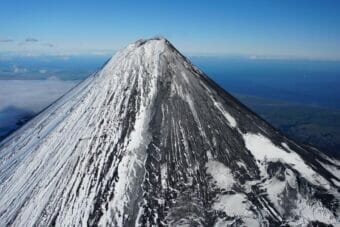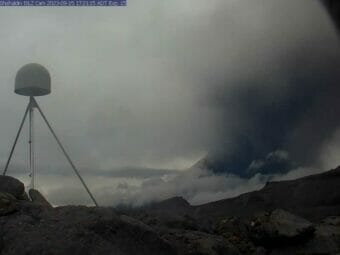
Researchers are looking to the past of Alaska’s Augustine volcano to find answers about its future. An ongoing research collaboration between the Alaska Volcano Observatory and scientists at Western Washington University seeks to broaden existing knowledge about the volcano to understand the true threat that it poses to Alaskans living in the Cook Inlet region.
The research is spearheaded by Kristina Walowski, an assistant geology professor at Western Washington University. In 2020, she and her colleagues received a grant from the National Science Foundation to study Augustine, located at the southwest end of the Cook Inlet, 170 miles from Anchorage and visible from nearby Homer. They conducted much of their research last summer and are in the process of compiling it.
“Augustine is one of our highest-threat volcanoes in Alaska,” said Matt Loewen, a research geologist at the Alaska Volcano Observatory, who is also involved in the research collaboration.
The volcano is of special interest to researchers like Walowski because of its proximity to Alaska’s largest city and its history of explosions. Augustine is a unique volcano because it has erupted six times in the past 200 years, Walowski said. The most recent eruption occurred in 2006 and greatly impacted air travel in the area.
But the recent eruption is not what is most interesting to Walowski and her team. They are focused on two eruptions in particular: one 400 years ago and one about 800 years ago. Those two eruptions were more explosive than recent ones, and Walowski and her team are attempting to understand why that was the case and what that might mean for the future.
“Why has [Augustine] changed its personality? And is there a potential for it to revert back to its old ways?” Walowski said.
Her team is studying rock material from the volcano to backtrack its life to see if Augustine might have another major eruption, similar to its past big eruptions, in its future. Looking at the components of rocks is essential because scientists can get an inside view into the pressure or temperature that formed that rock, Walowski said. And in turn, that information offers up clues about how the volcano behaved in the past and how it might act in the future.
But Walowski was quick to say that she does not work in predictions. Rather, she offers a window into the past of the volcano and what might happen in the future. With this information, she said that the Alaska Volcano Observatory could be better equipped to inform people about what may happen next with Augustine. One of the biggest threats of the volcano is the tsunamis that it might create caused by a large displacement of land matter in the event of an explosion. This happened once in 1883 and could happen again, according to the U.S. Geological Survey.
“We have a mission to, you know, both understand volcanoes and provide alerts and warnings about eruptions,” he said. “Well, the academic world tends to be more about developing fundamental research, and I think this is a great case where we’re putting those together. So they’re kind of mutually beneficial.”
Walowski hopes to see the research published in the next year or so. She is excited about its potential to create a broader picture of Augustine’s threat to Alaskans, so that more people may be better prepared in the event of an emergency.
“It’s important for the public to know that there are scientists working on understanding volcanoes at many different levels and all of those little puzzle pieces can be sort of stuck together to make people and communities as safe as possible,” she said.
This story originally appeared in the Alaska Beacon and is republished here with permission.



